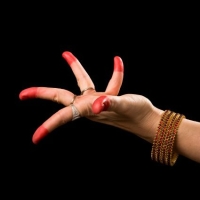About Kuchipudi
Kuchipudi is one of the eight recognized classical dance styles of India. The art form, particular to the state of Andhra Pradesh in South-India, is marked by fluid movement, dramatized expression and intricate footwork. From as early as 1000 A.D, scholars believed that spiritual aspects in the then-prevalent dance form had dwindled away and that there was a need to have a dance style, an art form that would counter this increasing seepage of the sensuous into the spiritual. Kuchipudi was born out of that renaissance movement.
What separates this 15th century dance form from its other classical Indian dance counterparts is the element of Vaachikaabhinaya - i.e, emoting through speech. Kuchipudi is at its core, a theatre and dance-drama tradition which means that the Kuchipudi ballets are embellished extensively with dialogues and melodic verses delivered by the protagonists on stage, for the concept of solo presentations were a much later development.
Kuchipudi owes its existence to the work of ascetic Sri Siddhendra Yogi, who dedicated his life to the dance style's growth and propagation through the composition of his magnum opus "ParijAtApaharanam", which later metamorphosed into the immortal "BhAmakalApam". Many illustrious personalities have nurtured this dance form through the centuries since then, and though originally male-dominated, today it is a dance style that has evolved from strength to strength, practiced across the globe by both men and women.



